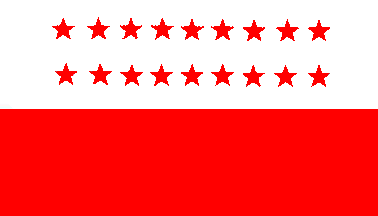
This page is part of © FOTW Flags Of The World website
Madagascar
Repoblikan'i Madagasikara
Last modified: 2014-06-21 by bruce berry
Keywords: madagascar | malagasy |
Links: FOTW homepage |
search |
disclaimer and copyright |
write us |
mirrors

![[Variant]](../misc/fis_vari.gif)
 2:3~ image by Antonio Martins, 24 April 1999
See also:
2:3~ image by Antonio Martins, 24 April 1999
See also:
Origin and description of the flag
National Flag. CSW/CSW 2:3
Tricolor consisting of white field by hoist and two horizontal fields
of red over green in the fly. Each of the fields is of the same area, i.e.
each has ratio 1:2, with overall proportion 2:3.
Željko Heimer, 21 May 2002
There are two references, which do not agree with each other, referring to this
flag:
Smith (1975) [smi75a]:
"Many Malagasy are descended from settlers who originally came from
South-East Asia, suggesting that its red and white flags (see Indonesia)
influenced similar red and white flags flown by the Hova empire in 19th
century Madagascar. Those Hova flags were the basis for the tricolor adopted
shortly after Madagascar became the Malagasy Republic. Green was added
for the coastal people.
Historically, red is associated with the Volamena and the white with
the Volafotsi, princely families founded by King Andriandahifotsi (1610-1685).
His personal emblem was a red bull and the name of the kingdom was
Menabe,
"Great Red".
DK Ultimate Pocket Book of Flags (1997) [rya97]:
"The red and white are said to symbolize the earlier
Merina Kingdom,
whose flags were all red and white, with the addition of the green for
the Hova, the former peasant class."
Both sources agree on the red and the white, but there is discrepancy
about the origin of the green. Encyclopaedia Universalis (CD-ROM edition,
1998) solves it, the DK Ultimate Pocket version being the correct one.
The history of Madagascar is very complex and I just extract details significant
for the green colour case. Smith was certainly fooled by sources dating from the French colonial
period (1885-1960). At that time, Merina and Hova were used as synonyms.
In fact, the Merina Kingdom (founded in 1787 by unifying several small
princely states of the island), had a very strict social hierarchy, based
on three main classes: the "andriana" (nobility), the "hova" (free commoners,
mostly peasants), and the "andevo" (black slaves). From time to time, the
Prime Minister of the Kingdom had been of Hova origin, and the Hova class was the source of quasi-permanent anti-French agitation. There
had never been any Hova Kingdom or "Hova Empire" as reported by Smith.
I do not know how the "coastal peoples" he mentioned were ranked in the
Merina system (they usually belong to different ethnic groups and still tend
to live in autarky, and I imagine they were of very low rank, if any),
but the green strip cannot be attributed to them (or it was a later "reattribution"
for political reasons). The Menabe kingdom mentioned by Smith was a powerful
state which could unify for several years the small kingdoms in permanent
state of war with each other.
Ivan Sache, 28 Jun 1999
Madagascar flag colors according to Album 2000 [pay00]:
"Official" Pantone and "approx." CMYK
R: Warm Red c / 0-80-90-0
G: 348c / 100-0-80-25
Santiago Dotor, 9 Feb 2001
Some time after 24 December 1959, when the "coat of arms" was adopted,
the new flag was devised (that may easily be only in 1960 as suggested
on FOTW), containing in the middle of the white stripes the golden emblem,
above it initials R.M. (for Repoblika Malgasy/Repoublique Malagashe in
Malagashe and French).
Željko Heimer, 28 Jun 1999
The protocol manual for the London 2012 Olympics
(Flags and Anthems Manual, London, 2012 [bib-lna.html])
provides recommendations for national flag designs. Each National Olympic
Committee was sent an image of their flag, including the PMS shades, by the
London Organising Committee of the Olympic Games (LOCOG) for their approval.
Once this was obtained, the LOCOG produced a 60 x 90 cm version of the flag for
further approval. So, while these specifications may not be the official,
government, version of each flag, they are certainly what the National Olympic
Committee believed their flag to be.
For Madagascar : PMS warm red, 348 green. The vertical flag is simply the
horizontal version turned 90 degrees clockwise.
Ian Sumner,
10 Oct 2012
Possible flag of the
1947-1948 uprising
 image by Jakub Grombíø, 14 Sep 2010
image by Jakub Grombíø, 14 Sep 2010
I found some description of the flag which was used during the anti-French
uprising in Madagascar between 1947 and 1948. The Czech book "Nejnovější dějiny Afriky" by Karel Lacina (1987) mentions
that rebels "fought under the traditional red and white flag of Malagasy kings"
- or more correctly the Merino kings because this revolt was led by the
Merino (Hovi) aristocracy and the other people of Madagascar did not participate
- "which was completed with eighteen stars symbolizing eighteen Malagasy
tribes." So it possibly looked like image above.
You can also see a similarity with the flag of the Malaya people of the same
time (because the Malaya and Malagasy are relatives) and flag of the
contemporary Malagasy Socialist Union which has 18 stars surrounding a
silhouette of a map of the Madagascar island.
Jakub Grombíø, 14 Sep 2010
For further historical background, go to mg-bg (Ed).
 image by Jakub Grombíø, 14 Sep 2010
image by Jakub Grombíø, 14 Sep 2010
